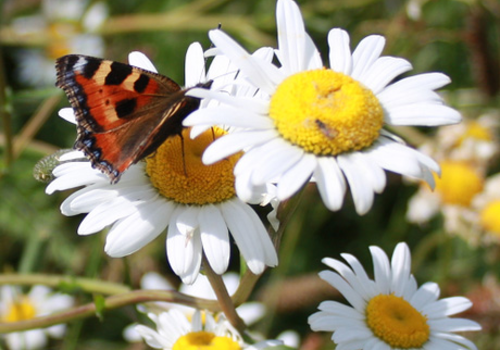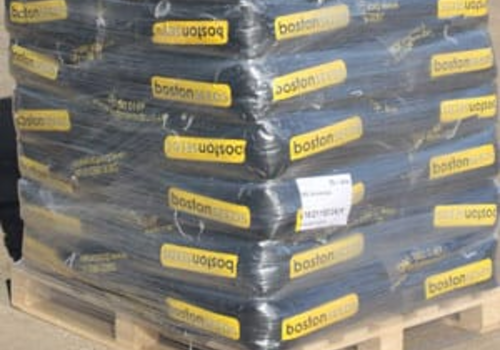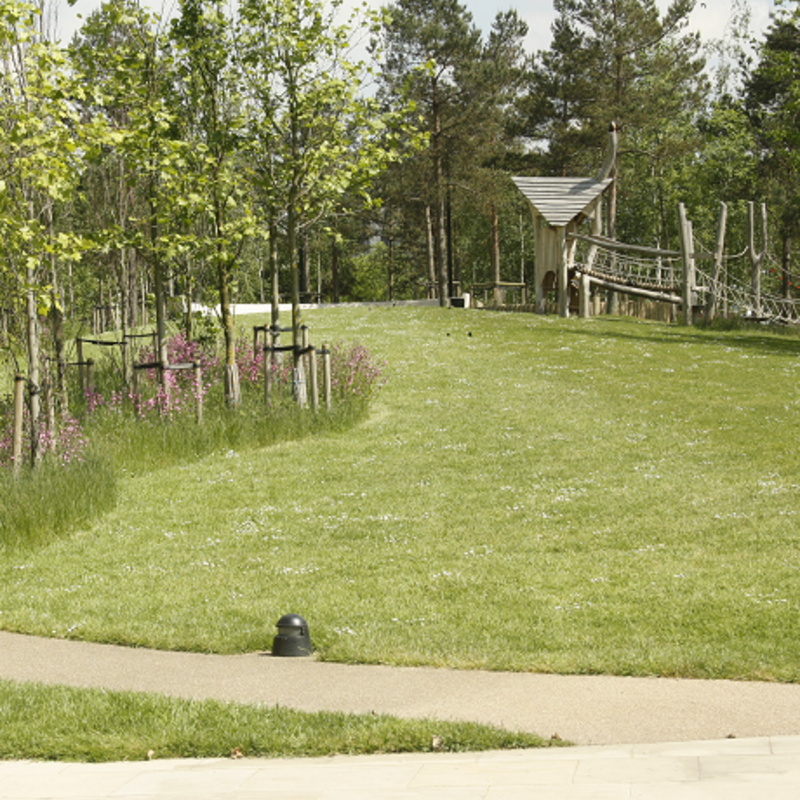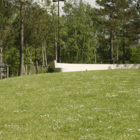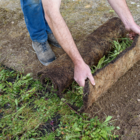Species Rich Lawn Turf®
Providing an excellent alternative to standard lawn turf, our Species Rich Turf creates a biodiverse lawn including flowering species. Including 26 species that can tolerate mowing, this turf is perfect in both shady and drought conditions, whilst providing pollen and nectar for beneficial insects.
- 80% Grass, 20% Flora - 20 Native wildflower species
- Copes well with shady conditions and is drought tolerant.
- Can cope with some wear and tear
- Minimum established height: 3cm. Maximum established height: 10cm
- Typical applications: lawns and gardens
This blend provides an easy solution to a species-rich lawn by combining 20 wildflowers with 6 grass species.
Our Standard Turf Range has been grown on for 8-12 weeks.
For further advice on how to get the best biodiverse area, visit our advice page!
Please note that your order will only be delivered from Tuesdays to Thursdays. Due to the nature of Wildflower Turf, it is cut and lifted at the point of order. Therefore, unfortunately, we’re unable to accept any cancellations or returns.
Mixture Specification
Turf size will vary with application but is generally 1m x 0.64m = 0.64m² slabbed or 1.62m x 0.77m = 1.25m² rolled.
| Flora (20%) | ||
| Betony | (Perennial) | UK Native |
| Birds-foot Trefoil | (Perennial) | UK Native |
| Black Medic | (Perennial) | UK Native |
| Common Cat's Ear | (Perennial) | UK Native |
| Common Knapweed | (Perennial) | UK Native |
| Common Sorrel | (Perennial) | UK Native |
| Cowslip | (Perennial) | UK Native |
| Daisy | (Perennial) | UK Native |
| Lady's Bedstraw | (Perennial) | UK Native |
| Meadow Buttercup | (Perennial) | UK Native |
| Meadow Vetchling | (Perennial) | UK Native |
| Pignut | (Perennial) | UK Native |
| Salad Burnet | (Perennial) | UK Native |
| Self-Heal | (Perennial) | UK Native |
| Smooth Bedstraw | (Perennial) | UK Native |
| Suckling Clover | (Perennial) | UK Native |
| White Clover | (Perennial) | UK Native |
| Wild Marjoram | (Perennial) | UK Native |
| Wild Red Clover | (Perennial) | UK Native |
| Yarrow | (Perennial) | UK Native |
| Grasses (80%) | ||
| Sheep's Fescue | ||
| Slender Creeping Red Fescue | ||
| Chewing's Fescue | ||
| Sweet Vernal Grass | ||
| Smaller Cat's Tail | ||
| Dwarf Ryegrass | ||
Sowing & Establishment
How to lay your Wildflower Turf
1 - Delivery
Depending on the time of year, your Wildflower Turf will be delivered on a pallet in either rolls or slabs. The turf should be laid within 24 hours of receiving the delivery to prevent drying out. If this is not viable, remove the turf from the pallet, unroll and keep watered until it’s able to be laid.
2 - Ground Preparation
Ensure any weeds or debris are removed from the area and take it back to bare earth. This can be done by using weedkiller or a plastic sheet.
3- Rotavate the Soil
Rotavate the area to a depth of 10cm to create a fine tilth by using either a rotavator or tiller. If any debris is brought to the surface, remove.
4 - Weed Prevention
Leave the soil fallow after rotavating for 1-2 weeks. Disturbance of the soil during rotavating can cause germination of weeds. Remove these before laying the turf.
5 - Final Ground Preparation
48 hours before turf installation, water the area until saturated.
6 - Turf Installation
Roll/lay out the turf and press into the bare soil to ensure good soil contact, without overlapping the edges. Ensure there are no gaps between edges of the turf as this will promote weed growth. The turf can be cut to fit around any awkward shapes.
7 - Watering
Water the turf after laying and ensure the soil beneath the turf is damp. Water generously in the first couple of weeks to avoid the turf drying out.
8 - Root Establishment
After a couple of days following the turf being laid, slowly lift a corner of the turf up to check the roots are starting to knit into the soil.
Maintenance
1 - Flowering
A unique ‘soil-less’ system, Wildflower Turf will flower within the first year if containing annuals. Perennials in the mix will flower from the second year onwards once the roots are fully established and have gone through a period of vernalisation.
2 - Fertiliser
Wildflowers prefer poorer soil types, so no fertiliser is required before or during establishment.
3 - Leaf Matter
If laying turf under trees, ensure that the leaf matter is removed as this can smother light for the young wildflowers and mulch back into the soil, enriching the area.
4 - Weeding
Gaps between each slab of turf can cause some dormant weed seeds to germinate once given the ideal conditions. Because of this, some common lawn weeds such as trefoil and plantain may appear – the best way to minimize this and remove the vigour is by either pulling them out or spot spraying.
5 - Spring Cut
Suited to an established meadow, an early spring cut (end of February/early March) will help tidy up the area ready for summer flowering. It is recommended not to cut any lower than 10cm as this can disturb the flowers starting to emerge. Remove the clippings after the cut. Cutting can either be done with a strimmer, mower (with the box off) or scythe.
6 - Autumn Cut
An autumn cut is required in order for annuals to self-seed and flower the following year, helping the meadow mature. Once the flowers have died back (around September/October) depending on the season, cut down to around 10cm in height and leave the cuttings on the surface for around 7-10 days. This will allow the seed heads to dry out and for the seed to drop into the soil. After this time, it is important to remove the cuttings to prevent them mulching back into the soil.
Turf Backing
Turf Backing
Why Choose Boston Seeds
Why choose Boston Seeds?
With over two decades of experience, Boston Seeds is a family-run business whose passion lies in creating beautiful outdoor spaces with high-quality lawn grass and wildflower seed mixtures. We stock everything you need to create a beautiful lawn or wildflower meadow, including lawn turf.
When buying from Boston Seeds, you also get:
- Quality assurance: Every lawn turf we offer is carefully cultivated and thoroughly tested to help you grow a healthy, vibrant lawn.
- Customer satisfaction: We take pride in providing the best possible service and products for our customers. If you’ve got any questions or concerns our team is always happy to help.
- Expert advice: We are always on hand to help provide advice on caring for your lawn to ensure it’s looking great. Take a look at our advice section or get in touch.
- Versatility: Whatever your needs, we’ve got the lawn turf for you.
How we can help!
At Boston Seeds we take pride in excellent customer service. We have been helping create beautiful lawns for years, so whatever you need, we can help.
With Next Day Delivery on hundreds of items too, choosing from our range of lawn turf couldn't be easier. Ordering regularly or looking for large volumes? Click here to apply for a trade account today - we review all applications within one working day.
FAQs
What is species rich lawn turf?
Species rich lawn turf blends grasses and wildflowers to create a more diverse, attractive, and resilient lawn that supports local biodiversity. Usually the turf will contain 80% of grass species and 20% wildflower species.
How to lay species rich lawn turf?
Prepare the area by removing weeds and debris, then water thoroughly 24–48 hours before delivery. Lay the turf on the day it arrives, pressing it firmly into the soil to ensure good contact. Don’t overlap edges, but make sure there are no gaps to prevent weeds growing in the gaps.
How to maintain species rich lawn turf?
Maintaining species rich lawn turf is quite simple, however it will require some maintenance. Keep newly laid turf moist to help it establish. Avoid using chemical fertilisers or weed killers - they can damage the wildflowers. Mow less frequently than a standard lawn, and consider leaving some areas uncut to allow wildflowers to bloom and reseed.
Buy With Confidence

